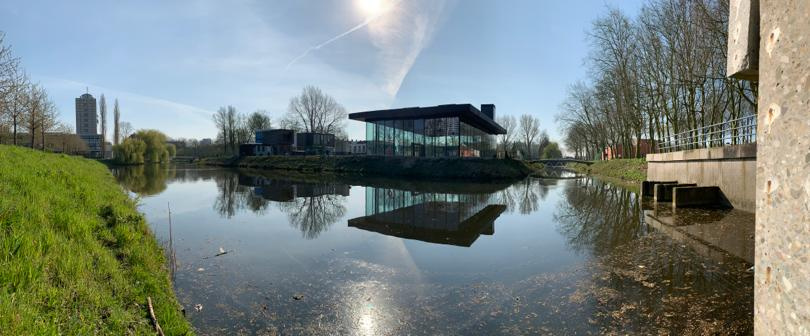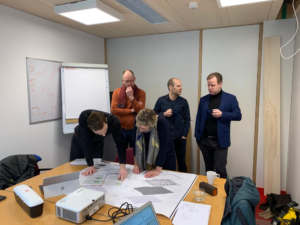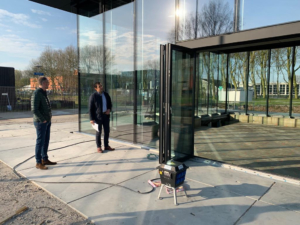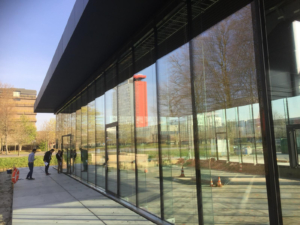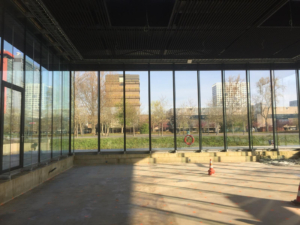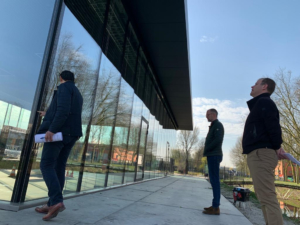Innovation is the economy of the future
The Co-Creation Centre is the place to be where innovation and co-creation are the focal points, which have come together in co-creation with TU Delft researchers and innovative entrepreneurs. This innovative and sustainable glass building at The Green Village on the TU Delft campus is formed by a collection of various research projects. The building is expected to serve as an events centre for inspiration, dialogue and work sessions starting this autumn. The Co-Creation Centre will form the heart of The Green Village, where steps towards a sustainable future are made through innovation and co-creation.
In the series of articles concerning innovations and research in the Co-Creation Centre (previously on Energy Piles, the circular foundation and the glass support structure), we are now focussing on the challenges that came along with the development, realisation and integration of all the research projects.
With these developments, realisations and integrations, the following people played a vital role: Diana de Krom – engineering company ABT, Armand Paardekooper Overman – Mecanoo architects, Erik van der Linden and Izzet Altuntas – construction company Kroon & de Koning, Tim Jonathan and Hubert Linssen – The Green Village and overall project leaders. We spoke with them about the benefits and challenges of this innovative construction process and the bottlenecks that could arise in these types of situations.
To innovate means to dare to fail.
“An innovative construction process is different to a traditional construction process. To put it simply, with a traditional construction process, there is a client with wishes, an architect with a design and a contractor who makes sure the idea comes to life. In short, a linear process”, according to Tim Jonathan.
“With an innovative construction process such as the Co-Creation Centre, the design comes together in co-creation. All together in one construction team, with input from the client, architect, engineers/advisors and contractor.” – Tim Jonathan
Such a process isn’t for everyone. “This construction process required a constant ‘can do’ attitude from all the team members and parties”, project manager Hubert Linssen adds. “Innovation has to be safe, but also needs to offer space. From robustness of the topic, meetings with various parties, to space for future integration of innovations. To innovate means to keep close contact with one another, listen and work together in co-creation.”
“When we first started there were no frameworks, they gradually developed.” – Erik van der Linden
With the development of new buildings one usually pays attention to what can be better or more energy efficient, but the development process of the Co-Creation Centre followed a completely different path. In this case, the innovations of the researchers formed the basis of the construction process. Are all those installations really necessary? Questions followed concerning air density, laws and regulations and how many people would fit into the building. This method requires more effort and proactivity. It makes the process and the innovation much more complex than with a traditional construction process, but simultaneously it offers the possibility to construct something more innovative.
“With radical innovation, you need to feel comfortable making mistakes. That means taking action instead of just talking. It’s important to embrace any insecurities that come from a project, so that it becomes easier for other parties outside of The Green Village to execute similar projects”, states Armand Paardekooper Overman enthusiastically.
“This construction process required a constant ‘can do’ attitude from all the team members and parties.” – Hubert Linssen
Integrality as extra challenge
The integrality of the various research projects formed an extra challenge. Kroon & de Koning had to wait for multiple go/no go moments, specifically with the collapse test of the glass fins. That dependency made the trajectory very tense for them, as they had to meet strict deadlines. In collaboration with the team they made a schedule in which the overall coherence was clarified. What happens when a test is delayed or unsuccessful?
“Those are tense moments during the process. There was also a plan B, and besides that, we tactically aimed to gain extra time to deliver our work on time. By using the auxiliary steel in a different way, we became less dependent upon the glass fins. Because of this, the go/no go moment of the collapse test was no longer crucial to our schedule and the construction process and creative process could continue alongside each other”, Izzet Altuntas explains.
Diana de Krom agrees that the integrality makes the process more challenging and complex. “You’re applying different innovations: Energy Piles and End Of Life concrete/Circuton. Subsequently you connect these two together, without knowing the prerequisites. That makes it all more complicated.”
Besides the Co-Creation Centre, the Energy Piles have also been applied to Converge. Converge is the climate system of the Co-Creation Centre as well as the climate tower besides it. The combination of various research projects forms the strength in this project, but also the challenge. For Kroon & de Koning this meant a collaboration with firm Van Dorp Installations, who were the research partner in project Converge.
“We offered each other enough freedom for mutual interests and goals, without placing a heavy cost burden on each other. The collaboration went smoothly. Bert van Dorp was very involved, enthusiastic and progressive.” – Izzet Altuntas
Hubert admires the way in which Kroon & de Koning took part in this innovative process. “Kroon & de Koning were constantly involved in finding solutions. Normally the contractor makes arrangements with third parties, but in this case they had to bring together Van Dorp and related researchers in the realisation phase. When one of the parties encountered some problems, Diana de Krom helped find a solution and Kroon & de Koning were very flexible about that. In a traditional construction process the contract is the focal point and you rely heavily on other parties to help out. That’s not possible with an innovative process, where flexibility and willingness to help are requirements.”
The bottleneck of sustainable innovation
If an innovative construction process leads to such innovative sustainable development, why don’t we apply this method more often? The revenue model within companies isn’t structured to facilitate it. During a traditional process, people work based on hours, whilst an innovative process requires more free time. The incentive lies in the sustainable character instead of the salary. Erik van der Linden sees opportunities for businesses to stimulate innovative processes. For example, by organizing special evenings or offering partnerships, like The Green Village does.
“Radical sustainable innovation is impossible within the current framework.” – Armand Paardekooper Overman
The biggest challenge however isn’t the revenue model or the wage structure. The current bottleneck regarding radical sustainable innovation concerns the laws and regulations. All the attendees seem to agree on this. Armand Paardekooper states: “Isn’t it strange that within the current framework of the laws and regulations, we’re expected to radically become more sustainably innovative? We take the current starting point and aim to become healthier, more energy efficient, and more efficient, while it should be the other way around. What do we want? What can we achieve? The regulations need to be organised based on that. That rarely happens in real life, but it’s an essential condition to bring these innovations, which we apply in the Living Labs at The Green Village, to practice.
“The first car looked like a carriage. It wasn’t until much later when we moved past the frameworks and something new was created. And that is necessary, as innovation is the economy of the future.” – Diana de Krom
There is an opportunity for businesses, government bodies and researchers to collectively work towards more freedom in the laws and regulations frameworks. Field labs such as The Green Village can act as a catalyst.
The ultimate test: the user
Since then, multiple research projects have started, which will test innovative materials and techniques. Research consortium Converge will come across the ultimate test, for example, when an event takes place on an extremely hot or cold day. Will it be pleasant to stand inside a glass building? Will the Co-Creation Centre work with the climate tower Converge and the energy foundation piles as the consortium had envisioned? All that needs to be put to practice. With new insights the innovations are validated and ready for the next level.
For more information
For more information about this project, please contact Tim Jonathan, Project Manager Buildings tim.jonathan@thegreenvillage.org or via +31 (0)6 19 19 34 21

